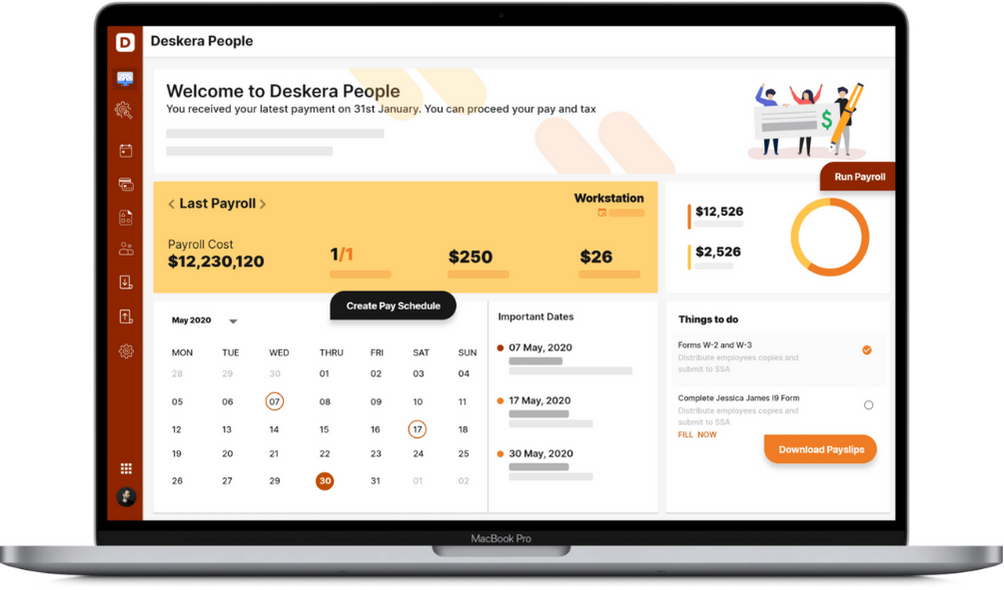We have all come across the stereotypical ‘pink’ and ‘blue’ outline, where pink is associated with femininity and blue with masculinity. As if this was not stereotypical enough, we have also seen a generation brought up with hostility and anxiousness against trans society.
Today, however, there is a growing awareness and rising demand for trans-inclusive workplaces. Being an employer who wants to assure a secured, safe, and fair, professional ecology within the organization, you must know about the best practices that can help you achieve that.

Here is what we shall be walking through.
- What does it mean to be transgender?
- The Causes of Stigmatization
- How to create a trans-inclusive workplace?
- Recognizing the rights of transgender employees
- Conclusion
- How can Deskera Help You?
- Key Takeaways
What does it mean to be Transgender?
As an employer striving to make a trans-inclusive workplace, you must first understand the legal definitions of transgender and ensure that your team is introduced to it. Your entire staff should be educated to behave respectfully and conduct in a reverential manner with a colleague from the trans community.
Transgender people are those whose gender identity differs from the sex they were biologically assigned. They might select various means of expressing their gender identity. For instance, some people might dress and act in a way consistent with the gender they identify with. Others can want to undergo surgery or hormone therapy to transform their bodies to fit their gender.
Recognizing Gender Identity and Expression
This section is significant as it helps you learn about the various expressions trans employees may choose for themselves. Different words are used by different people to express who they are and how they want to be identified. Although the terminology listed below is commonly used, we understand that their definitions and others' are always changing. Furthermore, it's crucial to remember that people are the best experts on their own identities and should always be asked how they would want to be referred to. Here is a small table that helps you learn about certain expressions:
The Causes of Stigmatization
Have you thought about why it is difficult for the transgender community to live normally and why they frequently experience stigma and prejudice? The way in which people have been guided into comprehending and expressing gender is the answer to the question. Gendered behavior is systematically induced in young children. Young boys and girls are pushed to act in stereotypically gendered ways from an early age.
Moreover, they are chastised for acting in non-normative ways. Likewise, girls are taught to behave and conduct themselves in a specific manner. Consider the custom of giving baby boys and girls blue and pink gifts, respectively. All these factors lead an individual to believe that they have a certain way that has been assigned to their gender; and anything that is slightly different from the ways that have been taught to them, they start doubting and stigmatizing it.
In order to gain parental approval and later acceptance from their peers, children try to conform to gender expectations. This is how the problem begins at the root.
Gender Norms pose a problem
Gender norms serve as possibly the most fundamental organizational structure by which people characterize one another as a result of this socialization. They are also very hard to alter because they are widely held and deeply ingrained. As seen in the last paragraph, these things have been introduced to young minds right at a young age. Transgender folks thus have a special problem. For instance, when a trans woman chooses to dress up as a female despite assigned being assigned male at birth, she defies expectations about how she should define and display her gender. The very fact that she ‘defies’ the expectation sets the loud tone of gender stigmatization.
We must understand that the affected people pay a hefty price for being in the zone and the discrimination faced by them is hard to eradicate. A survey in recent years has revealed that an astounding 75% have tried hiding their identities to avoid any kinds of mistreatment at work. This included hiding their gender identity, correcting people in the usage of pronouns for them, or delaying gender transition; unfortunately, many of them have even attempted dropping out of their employment.
The worst has been reported, including trans employees being forced to resign, having difficulty securing jobs, and being denied or delayed promotions. A considerable percentage also reported being ill-treated at the office over trivial matters such as being denied access to washrooms or not having bathrooms aligned with their gender identity. All these factors have collectively contributed to a disappointment for the transgender community.
How to create a Trans-inclusive Workplace?
Behaving respectfully or just normally as you would with any other human is one of the ways in which you can begin the process of having in place a trans-inclusive workplace. However, there is a lot more that you will need to take care of. First and foremost, you must draft a policy that includes and covers all the people working in your organization. You must include points to ensure all are treated equally, and none is left behind or left out just because they subscribe to a particular gender.
When you decide to build a workplace that is respectful toward transgenders, here are some points on how you can begin.
- Lowering gender bias in the hiring process
- Drawing out appropriate dress code policies
- Supporting gender transitions
- Creating training for trans-specific diversity
- Make use of interventions to promote adaptability
We shall look at these points more closely in the following sections.
Lowering gender bias in the hiring process
Certain recruiting procedures can aid in reducing the impact of unconscious bias when choosing candidates. Before analyzing applications and resumes, determine the importance of certain credentials, such as years of experience in a particular field, education, and technical skills. In order to minimize stereotype-based assessments, researchers also advise utilizing a candidate-selection procedure that emphasizes finding appropriate individuals rather than rejecting unsuitable ones. This will helps lower the judgments on the basis of stereotypes.
Dress code policies
Gender-neutral dress guidelines are being implemented in some organizations on a local level. Businesses can aid in de-stigmatizing different gender expressions by explicitly stating that all employees may choose from various alternatives, such as pantsuits, dress shirts, and skirt suits. By indicating that normativity is not expected, such policies may also help with recruiting and employee retention.
In your policy, you should also outline how to handle accommodations on the dress code. Any dress code that is implemented must be necessary for the job. Make sure the dress code at work does not support gender stereotypes. Every employee must adhere to the dress code consistently. However, ensure you do not lose out on a talented pool for not being comfortable with your dress-code policy.
Support Gender Transitions
Transitioning can be lengthy, starting with a profoundly personal choice that typically follows years of introspection. It can be difficult for the individual to decide whether to come out or reveal at work. Therefore, the decision should be left with them.
There are multiple advantages of doing so, such as not having to lead a double life or an isolated life behind closed doors, being able to express one's true self, and being true about oneself. Owing to these advantages, people tend to choose to transition.
Whoever decides to transition gets to decide how it will go. They may undergo Gender confirmation surgery. Some people who identify as gender-fluid spend their entire lives shifting between and within different gender expressions as they constantly reinterpret and redefine who they are. Therefore, it is recommended that employers create a complete strategy for handling gender transitions. Prioritize the individual and create a workplace that supports the process.
Here is how you can help them through the transitioning phase:
Providing healthcare benefits
You can extend help to cover the costs of the medical process by providing healthcare benefits. This could come as a great relief to them and also send across a message that is supportive and affirming of their decision.
Help from HR Manager
Your human resource manager can help them by providing crucial information regarding the process, treatment options, and support groups they may be looking for. The managers can also provide them with guidelines on handling their work amidst the process and not affect their work-life balance.
Team managers can extend support
The team managers can play an important role here by setting an example of extending the much-needed support at this fragile junction of their lives. The managers can also ensure that the other employees are empathetic and considerate about the whole issue.
Ask if any other assistance is required
Being an employer, you can further enquire if they need any other kind of assistance that you could provide. All these factors go a long way in maintaining a healthy professional relationship and also builds trust between you and your employees.
Create training for trans-specific diversity
To change attitudes and behavior toward particular groups, it is essential to create opportunities for people to interact with them, learn about their experiences, recognize their difficulties, and develop empathy. While the trans employees who have come out should be included in training only if they are willing, it is not the obligation of members of the LGBTQ+ community to educate others or to be visible in this way. You can get help from the numerous charitable LGBTQ+ organizations and corporate training companies that provide this training. Corporate diversity training can still be improved, even though media coverage has made gender identity and expression debates more accessible. Additional general education on gender-identity issues is crucial.
Make use of interventions that promote adaptability
The idea that transgender people can benefit from programs to assist them to reduce their tension and discomfort finds more acceptance today. The day after encountering a stigmatizing event at work, trans employees may be protected from emotional tiredness by mindfulness, a condition of nonjudgmental attitude.
Interventions can work truly well, especially, in the cases where trans employees have been misbehaved with or have been mistreated. Any unfair or disrespectful or distasteful mannerism should be dealt with in priority.
Recognizing the rights of transgender employees
We have seen how employers can aid the procedure of maintaining a peaceful and happy environment for everyone including transgender employees. However, apart from the rights offered by their employers, there are other ways in which their rights are safeguarded. Transgender workers are safeguarded by a number of federal, state, and local legislation, including the following:
Americans with Disabilities Act: Transvestism, transsexualism, and gender identity disorders are no longer considered to be disabilities as a result of ADA revisions. However, there are other medical conditions that some transgender employees may experience that could make them eligible for benefits under the law.
Family and Medical Leave Act: Some gender transitioning surgeries or treatments may be covered under FMLA. However, not all of them are. Follow standard notification processes and evaluate each incident individually to see if it qualifies. Also, keep in mind that some state FMLA laws offer transgender employees more rights than those offered at the federal level.
Affordable Care Act: Section 1557 of the Affordable Care Act (ACA) forbids sexism in the health insurance industry. However, until ongoing litigation is concluded, the execution of some provisions is unclear due to differing state judgments.
Title VII of the U.S. Civil Rights Act: Tha Act applies to employers with 15 or more employees. Title VII of the U.S. Civil Rights Act protects people against employment discrimination based on race, color, national origin, sex, and religion. The U.S. Supreme Court further held that the term "sex" in the Act's original meaning covers transgender rights and protects them.
Sadly, despite attempts by so many people and organizations, assuming that workplace initiatives can swiftly and easily eradicate discrimination toward trans employees is impractical. These adjustments require time. Additionally, while formal diversity policies and practices should be the main focus of employers in order to eradicate prejudice on a structural level, it's also critical to provide tools for minimizing the impact of that stigma.
Conclusion
People can only work to their greatest ability when they feel completely welcome, trusted, and committed to their organizations. The same holds true for trans personnel. However, very few businesses have successfully fostered an inclusive workplace for those who don't identify with social gender stereotypes.
We hope to have presented the preventive measures elaborately and our suggestions will contribute to a positive change. Employers who get this right go beyond merely being business savvy. Additionally, they are creating a business legacy that prioritizes respect for human dignity and views doing the right thing. This way they can assure their employees that they are integral and essential for business success.
How can Deskera Help You?
Deskera People has the tools to help you manage your payroll, leaves, employee onboarding process, and managing employee expenses, all in a single system. Features like a flexible payment schedule, custom payroll components, detailed reports, customizable pay slips, scanning, uploading expenses, and creating new leave types make your work simple.

Key Takeaways
- Transgender people are those whose gender identity differs from the sex to which they were biologically assigned. They might select various means of expressing their gender identity.
- It is important to recognize the various expressions used by the trans community to describe themselves. This includes cisgender, gender expression, genderqueer, and gender fluid.
- It is essential to learn about these expressions to build a comfortable environment for the trans community in the office.
- The gender norms cultivated in people from a young age can be problematic for trans people. It may be difficult to eradicate the deeply ingrained thoughts about the community, which may lead to an unaccepting environment for them.
- Problems faced by the trans community include facing denied job offers, promotions, delayed appreciation, and mistreatment among many others.
- Behaving respectfully or just normally as you would with any other human is one of how you can begin the process of having in place a trans-inclusive workplace.
- Some ways employers can create a trans-inclusive workplace include drawing out appropriate dress code policies, Supporting gender transitions, Creating training for trans-specific diversity, and using interventions to promote adaptability.
- There are multiple advantages of doing so such as not having to lead a double life or an isolated life behind closed doors, being able to express one's true self, and being true about oneself.
- Providing health care benefits and assistance from HR managers and team managers are some ways to help in the transitioning process.
- Corporate diversity training can still be improved, despite the fact that media coverage has made gender identity and expression debates more accessible. Additional general education on gender-identity issues is crucial.
- Apart from the rights offered by their employers, there are other ways in which their rights are safeguarded. Americans with Disabilities Act, Family and Medical Leave Act, Affordable Care Act (ACA), and Title VII of the U.S. Civil Rights Act are the other federal and local legislations that assist trans people.
Related Articles














